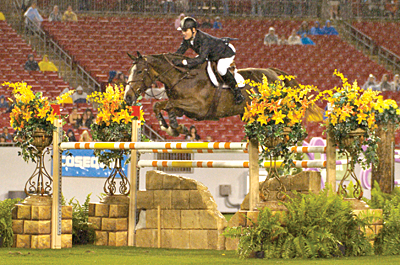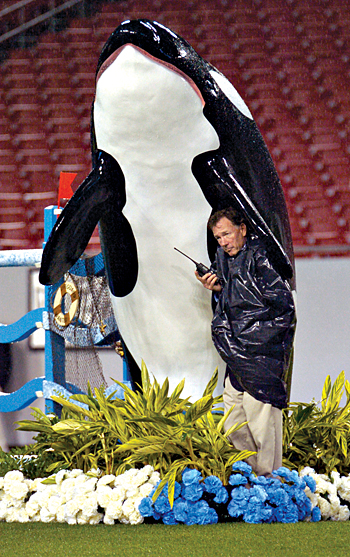Neither rain, nor wind, nor mud can keep the unflappable mare and McLain Ward from jumping clean.
The rails came raining down as Sapphire and McLain Ward progressed around the first round of the $200,000 Budweiser American Invitational.
 But it wasn’t the veteran chestnut mare toppling the timber—it was a sudden storm that blew over Raymond James Stadium in Tampa, Fla., midway through Ward’s round.
But it wasn’t the veteran chestnut mare toppling the timber—it was a sudden storm that blew over Raymond James Stadium in Tampa, Fla., midway through Ward’s round.
In what will go down as one of the most impressive performances in show jumping, Ward and Sapphire prevailed through a 40-minute delay in the middle of their first round and returned to finish the course clean. They then turned in the only clear jump-off round to take the $60,000 top check on April 5.
The evening began beautifully clear as Richard Spooner and Cristallo jumped clear as the first to go of 30 on the jump order. When Christine McCrea and Promised Land quickly joined them in the clear-round column as the third to go, it looked as if the jump-off might get crowded by the end of the night.
But Steve Stephens’ course began to take its toll. Out of the next 19 horses to go, none could pull off a clear round. There wasn’t one bogey spot—fences fell all around the course.
As Ward—23rd to go—cantered to the first fence, a light, steady rain fell.
|
Click here to see more photos from the $200,000 Budweiser American Invitational.
|
But as he progressed through the course, the wind changed to violent gusts and the rain began pelting down. As he jumped through the triple combination line of fences 6ABC and 7, jumps began toppling to the ground, and debris whipped across the ring. Sapphire didn’t blink an eye.
“To be honest, when I came in the ring, there was a light breeze, but I didn’t even think it’d be raining that hard by the time I finished my course, much less that I wouldn’t be able to finish. I think it got in a whirlwind in the stadium, as stadiums do sometimes, and got bad quickly,” Ward said. “It’s remarkable how Sapphire dealt with it.”
Ward pulled Sapphire up when the whistle blew to stop his round, and he waited at the in-gate. Members of the ground jury decided to excuse him from the ring and deliberate on their plan of action. They watched the weather radar and decided to try to finish the class after a 40-minute break.
The wind died down and the rain slowed. Ward was game to continue.
A Course Interrupted
Ward and Sapphire were allowed to jump the first fence again before they restarted from where they’d been stopped. Their first jump on course would be fence 8, an airy, narrow liverpool vertical.
Invitational TidbitsADVERTISEMENT
|
“To be honest, the question that was asked when I had to come back in the first round was remarkably difficult,” Ward said.“To start over a backward liverpool at 1.55-meters and then turn to a triple bar set four long strides to [a curved, solid] wall was really hard. The reason why those questions are later in a course is because you’re in a rhythm. That was an amazing test. Once Sapphire jumped the wall, she felt like she’d settled back in well. I didn’t ride the second-to-last fence very well and she had to strain over it, but she helped me out there.”
To the delight of the few hardy, wet spectators who remained, Ward and Sapphire left all the rails in the cups, making it three to jump off.
The field narrowed when four of the last seven riders in the order decided to scratch—Will Simpson, Nicole Shahinian-Simpson, Mac Cone and Eric Lamaze.
Chris Kappler, Margie Engle and Beezie Madden all decided to brave the elements and jump. Kappler, on VDL Oranta, and Madden, on crowd favorite and 2007 and 2005 American Invitational winner Authentic, both had heart-breaking rails late in the course that kept them from the jump-off. Engle and Hidden Creek’s Quervo Gold had two rails.
So, it would be three to jump off. Spooner returned on Cristallo and tried to set the pace, but Cristallo came down on the back rail of 6B, finishing with 4 faults in 41.76 seconds.
“It was rider error. I turned too tight there, and it was too long of a distance. He tried really hard to leave it up, but some things just can’t be done,” Spooner said.
 Spooner, who won up a storm at the HITS Desert Circuit in Thermal, Calif., this winter, flew to Florida for the class. He’s on his way to Europe with Cristallo, Ace and Paco to show for the summer.
Spooner, who won up a storm at the HITS Desert Circuit in Thermal, Calif., this winter, flew to Florida for the class. He’s on his way to Europe with Cristallo, Ace and Paco to show for the summer.
McCrea opted for a slower, careful approach, but when Promised Land pulled two rails and they collected 2 time faults, they were out of the running.
“My horse is a little bit more of a heavier mover—not super quick and fast. I felt like I got a bit stuck in the turns. But all in all, it wasn’t that bad. We just knocked ‘em down,” she said.
“My horse was great today, and I’m thrilled with him,” she added. “I just missed getting to go to Europe, so getting a ribbon in this big class is nice.”
Cleaning Up
All Ward had to do was canter around the jump-off clean, and that’s precisely what he did.
He and Sapphire put in another stellar round to pick up 1 time fault. “[Spooner and McCrea] did great but certainly made my work a little easier. It was a nice place to be,” Ward said.
Sapphire has been second, seventh and fourth in the Budweiser American Invitational. While she has a gold team medal from the 2004 Athens Olympics and a silver team medal from the 2006 World Equestrian Games (Germany) on her resume, she hasn’t won many classes.
ADVERTISEMENT
“It’s nice for Sapphire to win. I’ve always believed she’s one of the best horses in the sport in this country, and she’s always been second and third in a lot of big classes. She’s jumped in a lot of Nations Cups, so I’m happy for her to get some recognition,” Ward said.
Sapphire and Authentic are on the short list for the 2008 Olympics in Hong Kong and are headed to Europe for the summer to compete in Super League Nations Cups. Ward plans to take the younger Philippa to the FEI Show Jumping World Cup Final in Gothenburg, Sweden on April 24-27.
Simpson and Shahinian-Simpson are also on the Olympic short list, which probably factored into their decision not to jump in the Invitational. In addition, Cone and Lamaze are both in contention for the Canadian Olympic team.
“Everyone has to make a decision based not only on what suits their horse but also on the rest of their year,” Ward said.
“The Olympics are coming up. Nicki spoke to me, and her horse has been jumping the big classes for just a short amount of time and she’s going to Europe. All of those people really have other things coming up, and they have to take that into consideration,” Ward said.
“Sapphire has jumped in mud a lot, and it doesn’t seem to affect her,” he added. “Also, I was halfway done, so I had to take that into consideration. The horse had already made a great effort, so it didn’t make much sense not to go back and try and complete it. This is how we make our living.”
The Course
Steve Stephens designed a testing track for the $200,000 Budweiser American Invitational that included challenges throughout.
There wasn’t any one particular trouble spot. Riders started over the Budweiser oxer on the long side of the ring and negotiated a bending six strides to the aqueduct wall of arches that’s an Invitational feature. This year, the spaces under the arches were filled with white gates, and the fence didn’t cause any problems.
Fence 3 was a Swedish oxer, 5′ high and 4’11” wide, and then riders had to choose five or six strides between the vertical and oxer at fences 4 and 5. A quick rollback turn led them to the triple combination line.
The triple of vertical-oxer-vertical with one-stride distances caused a few rails but wasn’t particularly tough.
“The triple wasn’t all that big and difficult, so you didn’t have to max the horses out there and get them unsettled,” Richard Spooner said. In a tight five strides after the triple was a 5’6″-wide liverpool oxer. It was after this fence that McLain Ward was stopped in the first round.
A right turn led riders to fence 8, an airy vertical set over a liverpool. Then they rolled back to the left and jumped a triple-bar set 6′ wide. A long four-stride distance led to a curved, solid 5’3″ wall painted like a bridge. A few horses spooked a bit here, and the top blocks fell occasionally, but none stopped.
Along the short side of the ring was fence 11AB, a one-stride combination of square oxers that didn’t cause many problems. Fence 12 was an airy 5’4″ vertical. A rollback to the left led to the final line. Fence 13 was an airy oxer, 4’11” high and 5’3″ wide, that fell nine times in the course of the night. A bending six strides led to the final fence, a white gate set between Budweiser bottle standards.
Molly Sorge














